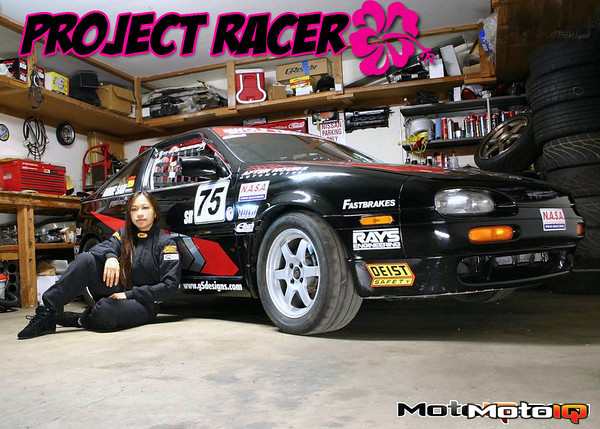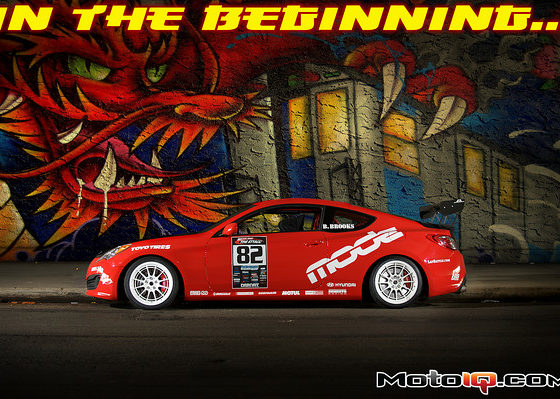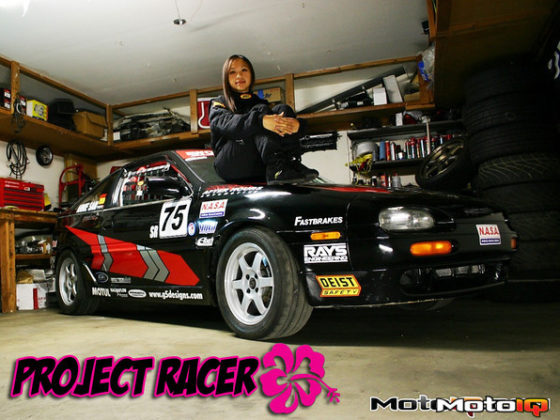
A Few Extra Tips
As I was instructing a beginner session at Willow Springs, I discovered several common mistakes that beginner drivers would make. So, I decided to add a little extra to this month's article point these out and hopefully help new drivers correct them before you head out to the track.
Common Mistake #1
A common mistake made by beginner drivers is braking in a turn. Unless you're a more advanced driver that is doing what is called “trail braking”, you should be making a conscious effort to brake only in a straight line. It is instinct for us to want to slow our cars down when we feel like we're going into a turn too fast, but braking while in a turn could lead you to the same results as if you had lifted off the throttle (results being: spinning out). More detail of this scenario will be mentioned in mistake #4.
 |
| When a beginner, don't be spastic and brake at the limit of traction in turns. In heavy race traffic such as this, it could cause some drama. Advanced braking while turning techniques such as left foot braking and trail braking will be covered later by Annie. |
Common Mistake #2
Another bad habit that I've noticed from beginner drivers is their incessant need to shift, and shifting while in a turn. Though it may feel faster to rip your car into a higher RPM when you're going into a turn the truth is, you're actually not. Shifting while in a turn can upset your car's balance, throwing the weight of your vehicle in places that can cause you to lose momentum or spin. Sometimes, drivers don't even realize that they're still in the middle of a shift after they've already entered the turn. When setting up for a turn, your car should be in gear, with your foot off the clutch before you dive into that turn. Basically, as a novice driver, make a conscious effort to get all of your braking and shifting done before entering a turn. The goal is to be ready to be on the throttle as soon as possible. If you are trying to shift or brake in a middle of a turn, it will delay you from getting on the throttle sooner.
 |
| Annie says “don't shift more than you have to!” |
Common Mistake #3
Check your gauges! A good practice is to glance down at your gauges at every straightaway to make sure your gauges are not giving you any red alerts. This can save your engine! Once, I was so intent on catching a car in front of me that I forgot to check my gauges. Next thing I knew, smoke was bellowing out from under my hood, coolant was spraying everywhere, and the needle in my temperature gauge had buried itself somewhere beyond hot. My freshly installed SR20 was completely blown. It was a bittersweet moment. Apparently I was good enough of a driver to be able to push my car to that point, but at the same time, I had blown my motor. As a result, I purchased an aluminum Koyo race radiator, and a set of Unorthodox under drive Pulleys to remedy this problem. Oh yeah, and a new motor. I call it my $300 mistake.
 |
 |
| If your car has basic (top) or more elaborate gages (bottom) give them a glance when it is safe to do so! |
Common Mistake #4
Lastly and most importantly, the most dangerous mistake is letting off the throttle completely when your car starts to over steer into a turn. It is instinctual to want your car to slow down when you are losing control, but in fact, that is the most dangerous thing to do. Letting off the throttle causes weight to transfer to the front wheels allowing the rear wheels to lose traction even more. In a FWD car, when you begin to slide (over steer) in a turn, mash onto the throttle and point your tires in the direction of the turn's exit. This will cause your front tires to pull you out of the turn in the right direction. Remember in a FWD car, “gas to save your ass.” A RWD car needs to have the throttle feathered but not completely lifted while applying counter steer. If correcting the spin is not possible, remember this phrase that was first recited to me: “when in doubt, both feet out, when you spin, both feet in” – meaning when you are not sure if you can make it through a turn at your current speed, back off the throttle (before you enter the turn). Do not completely lift, as that will disrupt the equilibrium of your car, which could send your car into a spin, just lightly and gradually lift off the gas. If you are already in a spin, punch both the clutch and the brake, lock up the wheels and let your car make its natural way off the course and out of the way of oncoming cars.
Blip the throttle with your heel to keep the engine from stalling while spinning so you can get out of harms way quickly later if need be. Attempting to fight the spin can place you in a dangerous situation, throwing you back onto the track and into oncoming traffic, or even worse, causing you to catch the edge of the track causing you to flip. If you put both feet in, the car will follow a natural trajectory safely away from the track and traffic. Most racetracks have a lot of runoff and most of the time, unless you were seriously going too fast, you won't hit anything solid. Had I known these tricks sooner, I may have saved myself hundreds of dollars in body damage.

But optimistically, I'm thankful that my vehicle was all that was damaged. And, I'm also thankful to Neo Tech Imports for helping me out with a great deal on replacement parts. As a result of this lesson, I retired my daily driven B18C1-powered Civic to the mere tasks of grocery getting, and bought the beloved NX2000 that you see here today as the star of “Project Racer”. Until next month… happy motoring!



